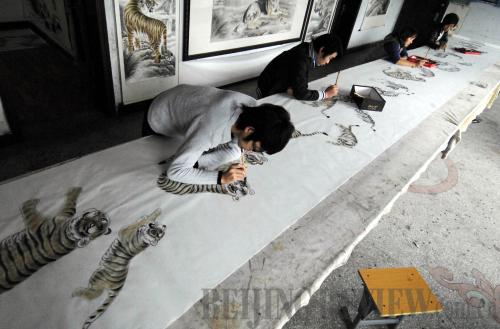|
 |
|
LEARNING A SKILL: Apprentices color a painting entitled One Hundred Tigers in Zhao Quanxi's studio in Wanggongzhuang Village in central China's Henan Province (LI BO) |
For the audio please click here
Xiao Yanqing, a farmer in his forties, could never have imagined his life could take a different turn when he started painting tigers in the late 1980s. Today, he is known as one of the Four Tiger Painting Masters in Wanggongzhuang Village in central China's Henan Province, where tiger culture and worship originated. He has built his own house, bought a car, and is now leading a better life.
The artist is just one among many tiger painters in the remote village. Today, over 50 percent of the 1,400 inhabitants make a similar living with "hoe in one hand, brush and ink in the other."
Painters are as old as at 70, and as young as 6. The town has won the name No.1 Village of Tiger Painting in China.
This village enjoys a long history of painting. "For generations, we mainly lived on farm land, but many families still kept the tradition of painting," he said.
"Although we seldom see real tigers, we are very familiar with the folklore about them. Tiger paintings, decorations, shoes and hats can be seen everywhere," said Xiao.
For instance, a tiger-head-shaped pillow is a traditional gift for a newborn baby in Xiao's village, as the animal is considered capable of warding off evil and bringing health as well as blessings.
Rural culture
In 2005, the Chinese Government promulgated the Decision on Further Strengthening Rural Culture Construction, which has made rural culture development a nationwide priority.
"Many villages have taken on a new look, and farmers are now living a better life compared to 10 years ago," said Pan Lusheng, Chairman of Shandong Federation of Literary and Art Circles and President of Shandong University of Art and Design.
Since 2006, Pan, with his team members, has visited over 200 villages to conduct a research project on rural cultural industry in Shandong Province.
According to research, the arts and handicrafts industry is a typical recycling economy, which doesn't pollute the environment like others. "Developing cultural industry has promoted rural growth and the restructuring of the local economy," he said.
The village set a good example of bettering rural people's lives through expanding the rural arts and handicrafts industry. "It increases income, which means farmers need not seek jobs elsewhere," he said. "It is also creative and artistic, which adds to the cultural modernity of the countryside."
In Wanggongzhuang, the streets and squares are clean, the yards are beautified and the whole village is greened. "All of these can be attributed partly to the tiger painting trade," said Xiao.
Cashing in
In the early 1990s, Xiao sold seven tiger paintings at the price of 100 yuan ($15.95) a piece. It stirred a sensation in the small village. When locals saw the benefits of painting tigers, some began to imitate and the number of farmer painters kept growing.
By the late 1990s, the Four Tiger Painting Masters reached a certain amount of fame. Many young people became their apprentices. Gradually, the painting industry took shape.
Wang Jianmin, one of the four masters, said that he has not done farm work for over 15 years. "I am grateful to my father who taught me painting skills, which I've taught to my daughter and son-in-law." The artist currently earns over 200,000 yuan ($31,898) every year painting tigers.
The trade has brought enormous economic returns to local people. In 2012 alone, more than 100,000 tiger paintings were created and sold at home and abroad, with a total output value of 60 million yuan ($9.57 million).
| 